Table of contents
- 1. Introduction to Genetics51m
- 2. Mendel's Laws of Inheritance3h 37m
- 3. Extensions to Mendelian Inheritance2h 41m
- 4. Genetic Mapping and Linkage2h 28m
- 5. Genetics of Bacteria and Viruses1h 21m
- 6. Chromosomal Variation1h 48m
- 7. DNA and Chromosome Structure56m
- 8. DNA Replication1h 10m
- 9. Mitosis and Meiosis1h 34m
- 10. Transcription1h 0m
- 11. Translation58m
- 12. Gene Regulation in Prokaryotes1h 19m
- 13. Gene Regulation in Eukaryotes44m
- 14. Genetic Control of Development44m
- 15. Genomes and Genomics1h 50m
- 16. Transposable Elements47m
- 17. Mutation, Repair, and Recombination1h 6m
- 18. Molecular Genetic Tools19m
- 19. Cancer Genetics29m
- 20. Quantitative Genetics1h 26m
- 21. Population Genetics50m
- 22. Evolutionary Genetics29m
13. Gene Regulation in Eukaryotes
Epigenetics, Chromatin Modifications, and Regulation
Problem 24e
Textbook Question
A particular type of anemia in humans, called β-thalassemia, results from a severe reduction or absence of the normal β-globin chain of hemoglobin. However, the γ-globin chain, normally only expressed during fetal development, can functionally substitute for β-globin. A variety of studies have explored the use of the nucleoside 5-azacytidine for the expression of γ-globin in adult patients with β-thalassemia.
Explain why this drug may also have some adverse side effects.
 Verified step by step guidance
Verified step by step guidance1
Understand that β-thalassemia is caused by a deficiency in the β-globin chain of hemoglobin, which is crucial for oxygen transport in adults.
Recognize that 5-azacytidine is a nucleoside analog that can induce the expression of γ-globin, which is normally expressed during fetal development, to compensate for the lack of β-globin.
Consider that 5-azacytidine works by incorporating into DNA and inhibiting DNA methylation, which can lead to the reactivation of fetal γ-globin genes in adult cells.
Acknowledge that while reactivating γ-globin can be beneficial for β-thalassemia patients, the demethylation effect of 5-azacytidine is not specific and can affect other genes, potentially leading to unintended gene expression changes.
Realize that these unintended changes in gene expression could result in adverse side effects, such as the activation of oncogenes or suppression of tumor suppressor genes, increasing the risk of cancer.
Recommended similar problem, with video answer:
 Verified Solution
Verified SolutionThis video solution was recommended by our tutors as helpful for the problem above
Video duration:
4mPlay a video:
Was this helpful?
Key Concepts
Here are the essential concepts you must grasp in order to answer the question correctly.
β-thalassemia
β-thalassemia is a genetic blood disorder characterized by reduced or absent production of the β-globin chain of hemoglobin, leading to anemia. This condition results from mutations in the HBB gene, which encodes the β-globin subunit. The lack of β-globin causes an imbalance in hemoglobin composition, resulting in ineffective erythropoiesis and hemolysis, which can lead to severe health complications.
γ-globin chain
The γ-globin chain is a component of fetal hemoglobin (HbF), which is predominantly produced during fetal development. In adults, the expression of γ-globin is typically suppressed, but it can substitute for β-globin in conditions like β-thalassemia. Therapeutic strategies, such as using 5-azacytidine, aim to reactivate γ-globin production in adults, potentially alleviating symptoms of the disease by improving hemoglobin function.
Recommended video:
Guided course

Proteins
5-azacytidine
5-azacytidine is a nucleoside analog that acts as a demethylating agent, influencing gene expression by altering DNA methylation patterns. This drug has been studied for its ability to induce the expression of γ-globin in patients with β-thalassemia. However, its use can lead to adverse side effects, such as cytotoxicity and potential impacts on normal hematopoiesis, due to its broad effects on gene regulation and cellular processes.






